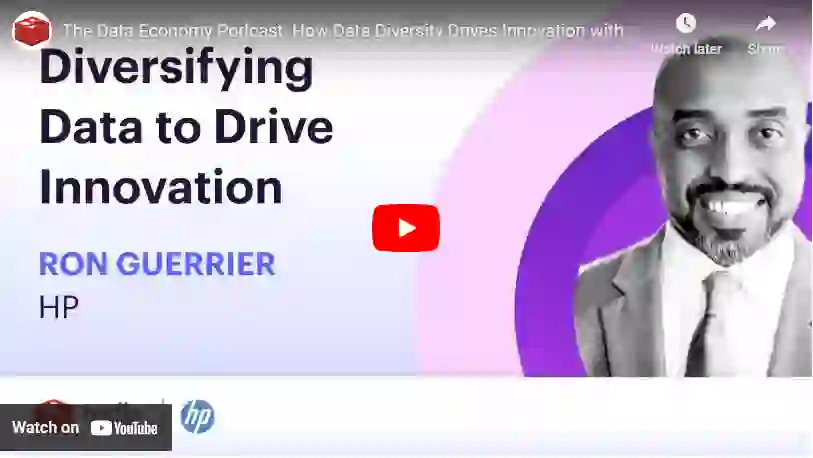
Learn more

The Data Economy is a video podcast series about leaders who use data to make positive impacts on their business, customers, and the world. To see all current episodes, explore the podcast episodes library below.
CIOs and CDOs (both digital and data) must execute in the present and transform their organization by developing a competitive edge with technology, data, and real-time experiences. But to succeed in a rapidly changing world, tech and data leaders must innovate a few steps ahead of the business need because of the time required to select target markets, align people, define capabilities, understand customer needs, and pilot capabilities.
Now innovation leaders are certainly thinking this way around emerging capabilities in artificial intelligence, machine learning, and IoT – but what fuels and differentiates these capabilities is working with diverse data sources and enabling real-time experiences.
You’ll learn a lot about this mindset—how to think, plan, align diverse teams, and partner with the business—from Ron Guerrier, HP’s CIO and guest of The Data Economy, a podcast presented by Redis and hosted by Michael Krigsman of CXOTalk.
During the podcast, Ron covers a ton of ground on CIO priorities, such as creating business opportunities through digital channels and addressing new market opportunities. He guides CIOs who are concerned that their existing apps don’t support the fast-growing digital demand. Most important, it’s his views on data diversity and enabling real-time experiences that stand out, and I picked several key statements from his conversation with industry analyst Michael Krigsman from CXOTalk to share with you.

I do more than my fair share of writing and speaking on the transformational CIO and becoming a digital and data-driven organization. But Ron nails some key and easy-to-understand directives for those CIOs and CDOs who are still learning the growth sides of their businesses.
“Innovation requires finding new markets and identifying different ways that we work and how we service our customers,” says Ron. “How do we personalize the relationship with the customers? How do we get ahead of what their wants and needs are? The best way to do that is to really understand the customer, whether it’s through metadata or other means, and develop solutions that cater to them.”
So innovation is not just about what customers need today. Innovation requires CIOs to partner with business leaders and develop a perspective on how to serve target markets differently.
But what’s really interesting is that Ron points out that collecting metadata is part of understanding and developing solutions for the customer. And since customer needs change quickly, developing customer solutions and real-time experiences requires capturing and processing real-time data.
Ron elaborates, “When it comes to customer experience, everyone expects that you know what I need. How do I get ahead of that, in a non-intrusive way, and use data to understand what the customer needs from us?”
Here’s how Ron explains data diversity in simple terms: “If you keep getting the same data points from the same sources over and over again, you get that same result. We have to ensure that we’re taking data from different constructs, different locations, and bring it together.”
In the podcast, Ron tells a story of a NASCAR fan’s changing interests and deciding to switch to Formula One.
And my example is a social media site showing me an ad for hiking pants two days after I completed my kayaking trip to Vermont. That site lacks data diversity and isn’t providing a real-time experience.
Ron goes on to describe the importance of real-time information. He asks, “How does the data flow, and [how do you] make sure that data goes from A to B at the right time frame? How old is the data? Because you don’t want to make decisions on latent data. What is the best-known information at this time? But the most important thing is, how do we refresh the data and make sure it stays relevant for decisions? How do we democratize data and get data to the edge?“
Real-time data is important for decision-making, but it’s also key to providing personalized, real-time experiences. “The customer doesn’t want just one cookie-cutter view,” he says. “They want differentiation. And so we have to understand that and provide differentiation in the data we provide.”
So, CIOs driving digital transformation must partner with their business leaders on innovations targeting new markets, integrate data from diverse sources, and select a platform that enables personalized, real-time experiences.
But CIOs and CDOs don’t work alone, and all of this requires building diverse teams. Ron compares the outdated approach to innovation (“It was thrown over the fence, wait for a while, get it back and pray that it’s what the customer wanted)” to a modern way of partnering with business leaders (“Let’s go to the beach together. Let’s find the rock we really want, and let’s try to find the right rock”).
In practical terms, “going to the beach together” means creating diverse teams, a learning culture, and tech leaders who are “able to sit with someone in marketing analytics, someone who is in sales or supply chain analytics, understand their business, and say, ‘You need this type of data because you’re trying to solve this problem.’”
One of Ron’s closing remarks is a reminder to CIOs on how to nurture diverse teams and innovation. “When diverse teams are in the ideation phase, it might take a little longer because it forces natural friction and different points of view,” he says. “But the outcomes are usually ten to twenty times better because they’ve thought of the problem in different ways and thought through different approaches. The data definitely supports why diversity matters.”
Tune in to the podcast episode to get more of Ron’s insights!
Watch more episodes of The Data Economy podcast.